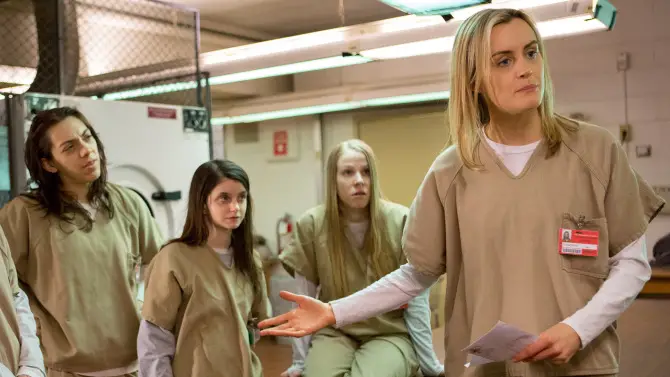On June 17, the moment millions of fans around the world eagerly awaited finally came: season four of “Orange is the New Black” arrived to Netflix. I sat down on my couch, ready to stream the season on my family’s new Smart TV. The anticipated hours of lesbian sex, prison violence and girl drama returning to my 49-inch screen for a fourth season was almost too much to handle. (True “OITNB” fans won’t even be phased by that sentence. Everyone knows this show isn’t for the faint of heart.) And for those who may not have watched the season yet, stop reading now to avoid any spoilers.
The season opens with two central situations that the audience watches develop throughout the entirety of the 13 episodes, introducing new problems and a new character dynamic. First, there’s an influx of new inmates at Litchfield, meaning the guards are cramming more beds into each bunk, and there’s a brand new host of inmates and officers to get to know. Things are a bit chaotic, and there isn’t much training provided for officers because they’re so desperately needed to keep the girls in line.
Secondly, the very first episode of the season gives fans the most ridiculous, unbelievable scenario yet: Alex, Lolly and Frieda kill a hit-man in the prison who was hired to murder Alex and pose as a guard. After beating and suffocating him, Frieda uses her expertise to help Alex and Lolly cut up the body and bury it in the fresh soil of the garden. They do this all under the noses of both officers and inmates.
Eventually, a new construction plan for the prison requires that the garden be uprooted, and (surprise, surprise) the body is discovered. A serious investigation ensues, conducted by the new captain, Piscatella, complete with hard interrogations.
If you ask me, the whole situation seems completely illogical. I don’t believe inmates would have the ability to kill a guard in prison today and keep the body hidden for so long. Not only that, but only Lolly is held accountable for the murder after admitting to it. I’m fairly certain that inmates could never actually get away with murder while serving time. Then again, I have never been to prison, so this presumption is something I’m okay with never finding out for sure.
As expected, the intermittent sex scenes (that I swear only happen when my parents are around) continue in season four, and Poussey and Soso are at the center of the action. These two showed viewers a bit of a romantic connection at the end of season three. And sure enough, season four is jam-packed with their blooming relationship. Though the sappy stuff doesn’t usually do much for me, their love for one another really is awe-inspiring.
They’re like the new Ellen Degeneres and Portia DeRossi—except, you know, criminals.
But a new trend adopted in season four was the show’s constant contemporary references, making the viewers feel much more connected to the prisoners, as if they could know them personally. There are casual mentions of Jay-Z, Beyoncé, Kanye West and Kim Kardashian. The inmates are even caught talking about television shows like “Breaking Bad” while they’re sitting around a table in the cafeteria.
Before this, few references were ever made to the time period of the show. Sure, there was an occasional smartphone or other modern piece of technology on screen, but this time there were actual pop culture references that almost made me feel like I was hearing a conversation among my friends. For the first time, I could really relate to what the girls were talking about.
Even more important, however, was the incorporation of the “Black Lives Matter” movement during the last few episodes. The BLM reference first arises when Soso paints Poussey as a troubled child growing up with a “crack whore.” Soso concocts the story for Judy King, an inmate who happens to be a cooking television show star (sound familiar, Martha Stewart?) in order to get her to notice Poussey, who is a devoted fan. In turn, Judy eats the story up. She believes the story Soso tells her without a second thought. But would she have accepted the story so easily if Poussey were Caucasian and blonde?
Like any television show, though, the producers left the most significant event for the last episode of season four, leaving me shocked, distraught and angry. In the final minutes of the season, the inmates hold a peaceful protest in the cafeteria, standing on the tables and uniting as a group to stop Captain Piscatella’s harsh treatment. Piscatella ends up ordering the COs to get the inmates off the tables, and Crazy Eyes is not having it. Poussey tries to calm her down, but Bayley restrains Poussey while fending off blows from Crazy Eyes. In his distraction, Bayley accidentally suffocates Poussey beneath his body weight.
Because viewers have grown with Bayley since season three, he is humanized a bit more than officers involved in real-life police brutality cases seen today. Fans watched him struggle to understand the injustice and mayhem in a corrupt prison as a young 21-year old correction officer. After all, the entire population of inmates escaped at the end of season three. The prison clearly isn’t run well, and it’s safe to assume that CO Bayley was never even properly trained.
Fans have also grown with Poussey, though, and they learned her back-story. She grew up in a military family and lived all over the world. She was kindhearted, sensitive and knew three languages. Poussey didn’t come from poverty or a family with drug addictions. She had a good head on her shoulders and, with her captivating smile, was easily one of the most beloved characters on the show.
Watching the death unfold on television between two well-liked, well-known characters makes the whole situation that much more complicated. When cases like Trayvon Martin’s, Freddie Gray’s and others’ are portrayed by mainstream media, it’s second nature for people to choose sides without even having witnessed anything or having known the full story. People will turn against one another, whether what they believe is fact or fiction.
What Poussey’s death does show us is that, although I believe CO Bayley made an awful, unforgivable mistake, Caputo defends him above all else. Justice for Poussey takes the backseat, and her father isn’t even notified about her death until days later. It’s upsetting and horrifying to watch, but the situation is not unlike real life.
At one point in the heart wrenching episode, the director makes Poussey and a young CO Bayley cross paths on a New York City street doing pretty much the exact same thing: partying and enjoying time with friends. This pivotal moment shows how two very similar people can be led down such drastically different paths in life based on their skin color. Bayley will go on to have a job in a corrupt prison, and Poussey will end up dead in that same jail at Bayley’s hands. It’s a system that black people today know all too well.
While an answer to the real problem of racial injustice isn’t straightforward or easy, it’s a part of our society that is worth exposing, discussing and understanding. The directors of the show did a phenomenal by intertwining the BLM movement into the show, and perhaps reached a different audience than the mainstream media. It was heartbreaking to watch Poussey die, but beneath the sadness, the directors are igniting a bigger inspiration for change.

















